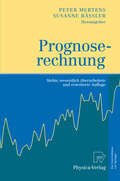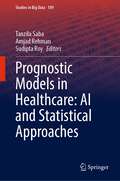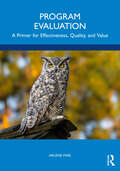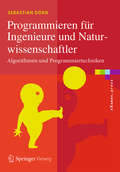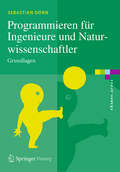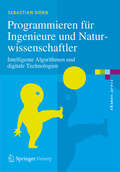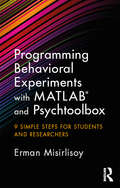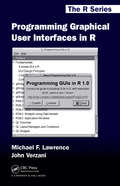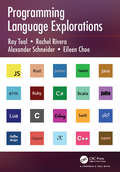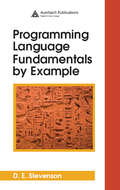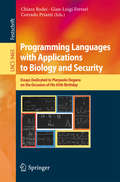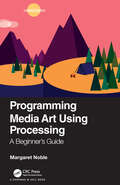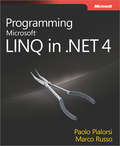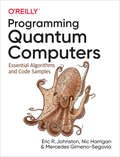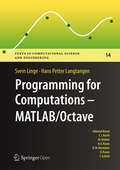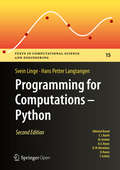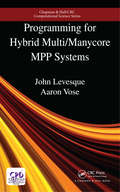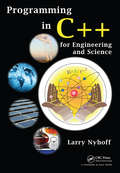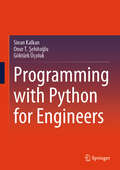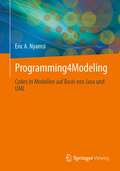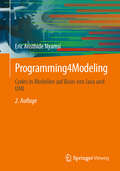- Table View
- List View
Prognoserechnung
by Peter Mertens Susanne RässlerMit diesem Buch liegen kompakte Beschreibungen von Prognoseverfahren vor, die vor allem in Systemen der betrieblichen Informationsverarbeitung eingesetzt werden. Praktiker mit langjähriger Prognoseerfahrung zeigen außerdem, wie die einzelnen Methoden in der Unternehmung Verwendung finden und wo die Probleme beim Einsatz liegen. Das Buch wendet sich gleichermaßen an Wissenschaft und Praxis. Das Spektrum reicht von einfachen Verfahren der Vorhersage über neuere Ansätze der künstlichen Intelligenz und Zeitreihenanalyse bis hin zur Prognose von Softwarezuverlässigkeit und zur kooperativen Vorhersage in Liefernetzen. In der siebenten, wesentlich überarbeiteten und erweiterten Auflage werden neue Vergleiche von Prognosemethoden, GARCH-Modelle zur Finanzmarktprognose, "Predictive Analytics" als Variante der "Business Intelligence" und die Kombination von Vorhersagen mit Elementen der Chaostheorie berücksichtigt.
Prognostic Models in Healthcare: AI and Statistical Approaches (Studies in Big Data #109)
by Sudipta Roy Tanzila Saba Amjad RehmanThis book focuses on contemporary technologies and research in computational intelligence that has reached the practical level and is now accessible in preclinical and clinical settings. This book's principal objective is to thoroughly understand significant technological breakthroughs and research results in predictive modeling in healthcare imaging and data analysis. Machine learning and deep learning could be used to fully automate the diagnosis and prognosis of patients in medical fields. The healthcare industry's emphasis has evolved from a clinical-centric to a patient-centric model. However, it is still facing several technical, computational, and ethical challenges. Big data analytics in health care is becoming a revolution in technical as well as societal well-being viewpoints. Moreover, in this age of big data, there is increased access to massive amounts of regularly gathered data from the healthcare industry that has necessitated the development of predictive models and automated solutions for the early identification of critical and chronic illnesses. The book contains high-quality, original work that will assist readers in realizing novel applications and contexts for deep learning architectures and algorithms, making it an indispensable reference guide for academic researchers, professionals, industrial software engineers, and innovative model developers in healthcare industry.
Program Evaluation: A Primer for Effectiveness, Quality, and Value
by Arlene FinkThis timely, unique, and insightful book provides students and practitioners with the tools and skills needed to evaluate social and policy programs across a range of disciplines—from public health to social work to education—enabling the allocation of scarce human and financial resources to advance the health and well-being of individuals and populations. The chapters are organized according to the main tasks involved in conducting an evaluation to produce unbiased evidence of program effectiveness, quality, and value. The chapters include methods for selecting and justifying evaluation questions or hypotheses, designing evaluations, sampling participants, selecting information sources, and ensuring reliable and valid measurement. The final section of the book is focused around managing and analyzing data and transparently reporting the results in written and oral form. The book features international case studies throughout, covers quantitative, qualitative, and mixed-method approaches, and is also informed by new online methods developed during the COVID-19 pandemic. Among the book’s unique features is a focus on international standards for conducting ethical evaluations and avoiding research misconduct. Also featuring checklists, example forms, and summaries of the key ideas and topics, this very practical book is essential reading for students in the social, behavioral, and health sciences, and will be a key resource for professionals in the field.
Programa de matemáticas [Grade 1], Libro del alumno: Libro del alumno (Grade 1) (ORIGO Stepping Stones)
by James Burnett Calvin Irons Peter StowasserNIMAC-sourced textbook
Programa de matemáticas: Libro de práctica (Grade 1) (ORIGO Stepping Stones)
by James Burnett Calvin Irons Peter StowasserNIMAC-sourced textbook
Programmieren für Ingenieure und Naturwissenschaftler
by Sebastian DörnZiel des Buches ist es, Studierenden der Ingenieur- oder Naturwissenschaften die Programmierung als Schlüsselqualifikation mit zahlreichen Anwendungsmöglichkeiten vorzustellen. Großer Wert wird auf eine praxisorientierte und verständliche Darstellung gelegt. Der Autor behandelt die Anwendungsbereiche des Operations Research, der Medizinischen Informatik und der Automatisierungstechnik. Neben der Darstellung objektorientierter Entwurfsmuster werden zentrale Programmierkonzepte und fortgeschrittene Datenstrukturen vorgestellt. Suchalgorithmen, Graphen, Automaten und reguläre Sprachen werden dem Leser praxisnah vermittelt. Die Grundlagen zur Bildverarbeitung im Bereich der Bildfilterung, Registrierung und Segmentierung runden das Buch ab.
Programmieren für Ingenieure und Naturwissenschaftler: Grundlagen (eXamen.press)
by Sebastian DörnZiel des Buches ist es, Studierenden der Ingenieur- oder Naturwissenschaften die Programmierung als Schlüsselqualifikation mit zahlreichen Anwendungsmöglichkeiten vorzustellen. Die Umsetzung von Programmierkonzepten und algorithmischen Verfahren erfolgt in diesem Buch in Java. Im ersten Teil gibt der Autor eine Einführung in die Grundkonzepte von Java, im zweiten Teil werden algorithmische Verfahren aus dem Bereich der Numerik, sowie allgemeine Methoden zum Entwurf von Algorithmen vorgestellt. Im dritten Teil werden Grundlagen der objektorientierten Programmierung dargestellt sowie ein Überblick über die Erstellung von graphischen Benutzeroberflächen gegeben. Ein Kapitel zu diversen Anwendungen aus dem Bereich der Ingenieur- und Naturwissenschaften sowie Aufgaben und Lösungen in jedem Kapitel runden das Buch ab.
Programmieren für Ingenieure und Naturwissenschaftler: Intelligente Algorithmen und digitale Technologien (eXamen.press)
by Sebastian DörnZiel des Buches ist es, Ingenieuren oder Naturwissenschaftlern die Programmierung als Schlüsselqualifikation mit zahlreichen Anwendungsmöglichkeiten vorzustellen. Der Autor erläutert algorithmische Methoden, die heute hinter digitalen Produkten und Dienstleistungen stehen. Zentrale Anwendungen sind die Künstliche Intelligenz, das Data Mining, die Predictive Analytics, die Industrie 4.0 oder das Internet der Dinge. Die digitale Datenanalyse mit den zugehörigen Algorithmen ist die zentrale Grundlage vieler neuer IT-Technologien. Hierzu werden große Datenmengen verschiedenster Anwendungsfelder verarbeitet und auf gewisse Muster analysiert, um die relevanten Informationen zu extrahieren. Diese sogenannten intelligenten Verfahren sind die Basis für nahezu alle Innovationen in unserer digitalisierten Welt. Mit Hilfe dieser Art der Informationsverarbeitung werden durch die Kombination von mathematischen Modellen und algorithmischen Verfahren neue digitale Geschäftsmodelle erschaffen.
Programming Behavioral Experiments with MATLAB and Psychtoolbox: 9 Simple Steps for Students and Researchers
by Erman MisirlisoyHuman behavior is fascinating so it’s no surprise that psychologists and neuroscientists spend their lives designing rigorous experiments to understand it. MATLAB is one of the most widely used pieces of software for designing and running behavioral experiments, and it opens up a world of quick and flexible experiment programming. This book offers a step-by-step guide to using MATLAB with Psychtoolbox to create customisable experiments. Its pocket size and simple language allow you to get straight to the point and help you to learn fast in order to complete your work in great time. In nine simple steps, it guides you all the way from setting parameters for your experiment to analysing the output. Gone are the daunting days of working through hundreds of irrelevant and complicated documents, as in this handy book, Erman Misirlisoy coaxes you in the right direction with his friendly and encouraging tricks and tips. If you want to learn how to develop your own experiments to collect and analyse behavioral data, then this book is a must-read. Whether you are a student in experimental psychology, a researcher in cognitive neuroscience, or simply someone who wants to run behavioral tasks on your friends for fun, this book will offer you the skills to succeed.
Programming Graphical User Interfaces in R (Chapman & Hall/CRC The R Series #5)
by Michael Lawrence John VerzaniProgramming Graphical User Interfaces with R introduces each of the major R packages for GUI programming: RGtk2, qtbase, Tcl/Tk, and gWidgets. With examples woven through the text as well as stand-alone demonstrations of simple yet reasonably complete applications, the book features topics especially relevant to statisticians who aim to provide a practical interface to functionality implemented in R. The book offers: A how-to guide for developing GUIs within R The fundamentals for users with limited knowledge of programming within R and other languages GUI design for specific functions or as learning tools The accompanying package, ProgGUIinR, includes the complete code for all examples as well as functions for browsing the examples from the respective chapters. Accessible to seasoned, novice, and occasional R users, this book shows that for many purposes, adding a graphical interface to one’s work is not terribly sophisticated or time consuming.
Programming Language Explorations
by Ray Toal Rachel Rivera Alexander Schneider Eileen Choe<P><P><i>Advisory: Bookshare has learned that this book offers only partial accessibility. We have kept it in the collection because it is useful for some of our members. Benetech is actively working on projects to improve accessibility issues such as these.</i> <P><P> Programming Language Explorations is a tour of several modern programming languages in use today. The book teaches fundamental language concepts using a language-by-language approach. As each language is presented, the authors introduce new concepts as they appear, and revisit familiar ones, comparing their implementation with those from languages seen in prior chapters. The goal is to present and explain common theoretical concepts of language design and usage, illustrated in the context of practical language overviews. <P><P>Twelve languages have been carefully chosen to illustrate a wide range of programming styles and paradigms. The book introduces each language with a common trio of example programs, and continues with a brief tour of its basic elements, type system, functional forms, scoping rules, concurrency patterns, and sometimes, metaprogramming facilities. <P><P>Each language chapter ends with a summary, pointers to open source projects, references to materials for further study, and a collection of exercises, designed as further explorations. Following the twelve featured language chapters, the authors provide a brief tour of over two dozen additional languages, and a summary chapter bringing together many of the questions explored throughout the text. <P><P>Targeted to both professionals and advanced college undergraduates looking to expand the range of languages and programming patterns they can apply in their work and studies, the book pays attention to modern programming practice, covers cutting-edge languages and patterns, and provides many runnable examples, all of which can be found in an online GitHub repository. The exploration style places this book between a tutorial and a reference, with a focus on the concepts and practices underlying programming language design and usage. Instructors looking for material to supplement a programming languages or software engineering course may find the approach unconventional, but hopefully, a lot more fun.
Programming Language Explorations
by Ray Toal Sage Strieker Marco BerardiniProgramming Language Explorations helps its readers gain proficiency in programming language practice and theory by presenting both example-focused, chapter-length explorations of fourteen important programming languages and detailed discussions of the major concepts transcending multiple languages. A language-by-language approach is sandwiched between an introductory chapter that motivates and lays out the major concepts of the field and a final chapter that brings together all that was learned in the middle chapters into a coherent and organized view of the field.Each of the featured languages in the middle chapters is introduced with a common trio of example programs and followed by a tour of its basic language features and coverage of interesting aspects from its type system, functional forms, scoping rules, concurrency patterns, and metaprogramming facilities. These chapters are followed by a brief tour of over 40 additional languages designed to enhance the reader’s appreciation of the breadth of the programming language landscape and to motivate further study.Targeted to both professionals and advanced college undergraduates looking to expand the range of languages and programming patterns they can apply in their work and studies, the book pays attention to modern programming practices, keeps a focus on cutting-edge programming patterns, and provides many runnable examples, all of which are available in the book’s companion GitHub repository. The combination of conceptual overviews with exploratory example-focused coverage of individual programming languages provides its readers with the foundation for more effectively authoring programs, prompting AI programming assistants, and, perhaps most importantly, learning—and creating—new languages.
Programming Language Fundamentals by Example
by D.E. StevensonSurveying the major programming languages that have hallmarked the evolution of computing, Programming Language Fundamentals by Example provides an understanding of the many languages and notations used in computer science, the formal models used to design phases, and the foundations of languages including linguistics. This textbook guides students through the process of implementing a simple interpreter with case-based exercises, questions, and a semester-long project that encompasses all of the concepts and theories presented in the book into one concrete example. It covers also such topics as formal grammars, automata, denotational and axiomatic semantics, and rule-based presentation.
Programming Languages with Applications to Biology and Security
by Chiara Bodei Gian-Luigi Ferrari Corrado PriamiThis Festschrift volume is published in honor of Pierpaolo Degano on the occasion of his 65th birthday and is the outcome of a colloquium held in Pisa, Italy, in June 2015. Pierpaolo Degano has worked on a large variety of topics including formal program semantics, concurrency theory, systems biology and security. The volume contains 22 refereed papers and one extended abstract, including personal memoirs and regular research papers by close collaborators and friends and a laudatio illustrating his distinguished career and his main scientific contributions. The papers deal with the main research topics explored by Pierpaolo Degano and those still under his investigation.
Programming Media Art Using Processing: A Beginner's Guide
by Margaret NobleProgramming Media Art Using Processing: A Beginner's Guide provides an entry-level exploration into visual design through computer programming using the open source and artist-friendly language, Processing. Used by hundreds of students, this learning system breaks lessons down into strategic steps towards fun and creative media art projects. This book provides a linear series of lessons with step-by-step examples that lead to beginning media art projects, including abstract designs, pixel landscapes, rollover animations, and simple video games. Computer programming can be overwhelming for the first-time learner, but this book makes the learning of code more digestible and fun through a full color, well-diagrammed, and deeply explained text presentation. Lessons are rhythmically broken down into digestible parts with code annotations and illustrations that help learners focus on the details one step at a time. The content is legible, flexible, and fun to work with because of its project-based nature. By following the lessons and producing the projects sequentially in this book, readers will develop the beginning foundational skills needed to understand computer programming basics across many languages and also explore the art of graphic design. Ultimately, this is a hands-on, practical guide.
Programming Microsoft® LINQ in Microsoft .NET Framework 4
by Marco Russo Paolo PialorsiDig into LINQ -- and transform the way you work with data. With LINQ, you can query data from a variety of sources -- including databases, objects, and XML files -- directly from Microsoft Visual Basic® or C#. Guided by data-access experts who've worked in depth with LINQ and the Microsoft development teams, you'll learn how .NET Framework 4 implements LINQ, and how to exploit it. Clear examples show you how to deliver your own data-access solutions faster and with leaner code. Discover how to: Use LINQ to query databases, object collections, arrays, XML, Microsoft Excel® files, and other sources Apply LINQ best practices to build data-enabled .NET applications and services Manipulate data in a relational database with ADO.NET Entity Framework or LINQ to SQL Read, write, and manage XML content more efficiently with LINQ to XML Extend LINQ to support additional data sources by creating custom operators and providers Examine other implementations, such as LINQ to SharePoint® Use LINQ within the data, business, and service layers of a distributed application Get code samples on the Web
Programming Quantum Computers: Essential Algorithms and Code Samples
by Eric R. Johnston Nic Harrigan Mercedes Gimeno-SegoviaQuantum computers are poised to kick-start a new computing revolution—and you can join in right away. If you’re in software engineering, computer graphics, data science, or just an intrigued computerphile, this book provides a hands-on programmer’s guide to understanding quantum computing. Rather than labor through math and theory, you’ll work directly with examples that demonstrate this technology’s unique capabilities.Quantum computing specialists Eric Johnston, Nic Harrigan, and Mercedes Gimeno-Segovia show you how to build the skills, tools, and intuition required to write quantum programs at the center of applications. You’ll understand what quantum computers can do and learn how to identify the types of problems they can solve.This book includes three multichapter sections:Programming for a QPU—Explore core concepts for programming quantum processing units, including how to describe and manipulate qubits and how to perform quantum teleportation.QPU Primitives—Learn algorithmic primitives and techniques, including amplitude amplification, the Quantum Fourier Transform, and phase estimation.QPU Applications—Investigate how QPU primitives are used to build existing applications, including quantum search techniques and Shor’s factoring algorithm.
Programming for Computations - MATLAB/Octave
by Svein Linge Hans Petter LangtangenThis book presentscomputer programming as a keymethod for solving mathematical problems. There are two versions of the book,one for MATLAB and onefor Python. The book wasinspired by the Springer bookTCSE 6: A Primer on Scientific Programming with Python (by Langtangen), but the style is more accessible andconcise, in keeping with the needs of engineering students. The book outlines the shortest possible path from no previous experience with programming to a set ofskills that allows the students to write simple programs for solving commonmathematical problems withnumerical methods in engineering and science courses. The emphasis is on generic algorithms, cleandesign of programs, use of functions, and automatic tests for verification.
Programming for Computations - Python: A Gentle Introduction to Numerical Simulations with Python 3.6 (Texts in Computational Science and Engineering #15)
by Svein Linge Hans Petter LangtangenThis book is published open access under a CC BY 4.0 license. This book presents computer programming as a key method for solving mathematical problems. This second edition of the well-received book has been extensively revised: All code is now written in Python version 3.6 (no longer version 2.7). In addition, the two first chapters of the previous edition have been extended and split up into five new chapters, thus expanding the introduction to programming from 50 to 150 pages. Throughout the book, the explanations provided are now more detailed, previous examples have been modified, and new sections, examples and exercises have been added. Also, a number of small errors have been corrected. The book was inspired by the Springer book TCSE 6: A Primer on Scientific Programming with Python (by Langtangen), but the style employed is more accessible and concise, in keeping with the needs of engineering students. The book outlines the shortest possible path from no previous experience with programming to a set of skills that allows students to write simple programs for solving common mathematical problems with numerical methods in the context of engineering and science courses. The emphasis is on generic algorithms, clean program design, the use of functions, and automatic tests for verification.
Programming for Hybrid Multi/Manycore MPP Systems (Chapman & Hall/CRC Computational Science)
by John Levesque Aaron Vose"Ask not what your compiler can do for you, ask what you can do for your compiler."--John Levesque, Director of Cray’s Supercomputing Centers of Excellence <P><P>The next decade of computationally intense computing lies with more powerful multi/manycore nodes where processors share a large memory space. These nodes will be the building block for systems that range from a single node workstation up to systems approaching the exaflop regime. The node itself will consist of 10’s to 100’s of MIMD (multiple instruction, multiple data) processing units with SIMD (single instruction, multiple data) parallel instructions. Since a standard, affordable memory architecture will not be able to supply the bandwidth required by these cores, new memory organizations will be introduced. These new node architectures will represent a significant challenge to application developers. <P><P>Programming for Hybrid Multi/Manycore MPP Systems attempts to briefly describe the current state-of-the-art in programming these systems, and proposes an approach for developing a performance-portable application that can effectively utilize all of these systems from a single application. The book starts with a strategy for optimizing an application for multi/manycore architectures. It then looks at the three typical architectures, covering their advantages and disadvantages. <P><P>The next section of the book explores the other important component of the target—the compiler. The compiler will ultimately convert the input language to executable code on the target, and the book explores how to make the compiler do what we want. The book then talks about gathering runtime statistics from running the application on the important problem sets previously discussed. <P><P>How best to utilize available memory bandwidth and virtualization is covered next, along with hybridization of a program. The last part of the book includes several major applications, and examines future hardware advancements and how the application developer may prepare for those advancements.
Programming in C++ for Engineering and Science
by Larry NyhoffDeveloped from the author's many years of teaching computing courses, Programming in C++ for Engineering and Science guides students in designing programs to solve real problems encountered in engineering and scientific applications. These problems include radioactive decay, pollution indexes, digital circuits, differential equations, Internet addr
Programming with MATLAB for Scientists: A Beginner’s Introduction
by Eugeniy E. Mikhailov<p>This book offers an introduction to the basics of MATLAB programming to scientists and engineers. The author leads with engaging examples to build a working knowledge, specifically geared to those with science and engineering backgrounds. The reader is empowered to model and simulate real systems, as well as present and analyze everyday data sets. In order to achieve those goals, the contents bypass excessive "under the hood" details, and instead gets right down to the essential, practical foundations for successful programming and modeling. Readers will benefit from the following features: <li>Teaches programming to scientists and engineers using a problem-based approach, leading with illustrative and interesting examples. <li>Emphasizes a hands-on approach, with "must know" information and minimal technical details. <li>Utilizes examples from science and engineering to showcase the application of learned concepts on real problems. <li>Showcases modeling of real systems, gradually advancing from simpler to more challenging problems. <li>Highlights the practical uses of data processing and analysis in everyday life.</li>
Programming with Python for Engineers
by Göktürk Üçoluk Sinan Kalkan Onur T. ŞehitoğluThis book introduces computing and programming with undergraduate engineering students in mind. It uses Python (Version 3) as the programming language, chosen for its simplicity, readability, wide applicability and large collection of libraries. After introducing engineering-related Python libraries, such as NumPy, Pandas, Matplotlib, Sci-kit, Programming with Python for Engineers shows how Python can be used to implement methods common in a wide spectrum of engineering-related problems drawn from (for example): design, control, decision-making, scheduling and planning. Important features of the book include the following: The book contains interactive content for illustration of important concepts, where the user can provide input and by clicking buttons, trace through the steps. Each chapter is also accessible as a Jupyter Notebook page and every code piece is executable. This allows the readers to run code examples in chapters immediately, to make changes and gain a better grasp of the concepts presented. The coverage of topics is complemented by illustrative examples and exercises. For instructors adopting the textbook, a solutions manual is provided at https://sites.google.com/springernature.com/extramaterial/lecturer-material.
Programming4Modeling: Codes in Modellen auf Basis von Java und UML
by Eric A. NyamsiDas Buch fokussiert auf objektorientierte Softwareentwicklung in Bezug auf das Konzept "Programming4Modeling" genannt "P4M". Es stellt zum einen die Analyse und Design für die Modellierung mit UML und zum anderen die Softwareentwicklung mit Java dar. Das Buch wirft folgende Fragen auf: Wie ist die Architektur eines Klassenmodells? Welche Codes ermöglichen eine effiziente Softwareentwicklung? Was sind die Schnittpunkte von Codes und Modellen?
Programming4Modeling: Codes in Modellen auf Basis von Java und UML
by Eric Aristhide NyamsiDas Buch fokussiert auf objektorientierte Softwareentwicklung in Bezug auf das Konzept „Programming4Modeling“ genannt „P4M“. Es stellt zum einen die Analyse und Design für die Modellierung mit UML und zum anderen die Softwareentwicklung mit Java dar. Das Buch wirft folgende Fragen auf: Wie ist die Architektur eines Klassenmodells? Welche Codes ermöglichen eine effiziente Softwareentwicklung? Was sind die Schnittpunkte von Codes und Modellen?
